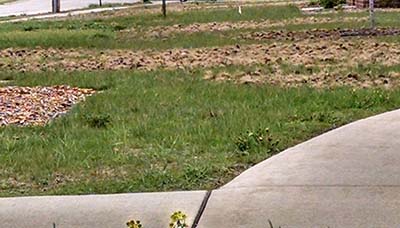Healthy lawns are more resilient to grubs, drought and other stressors
Use these Smart Gardening practices to have a healthy lawn that is more resilient to potential turf problems.

The snow is finally gone and lawn season is here. You may be noticing your lawn isn’t looking the greatest. A number of lawns in Michigan’s Upper Peninsula are showing large areas of dead patches, tunneling and holes, and just don’t look optimal.
What causes these problems and what can you do to help prevent these issues from showing up again? The Michigan State University Extension Smart Gardening program offers many practices that will help create healthier lawns that are more resilient to potential problems.
Dead turf can be caused by a number of reasons, including grubs, moles and salt damage. Finding the actual cause is key to solving these problems. You don’t want to just guess what caused your issue and move ahead with a treatment or potential solution. Not only will this be ineffective, but it will also cost you extra time and money, as well as create possible negative environmental effects.
MSU Extension provides a number of home gardening diagnostic resources to assist residents with questions such as these. MSU Extension’s toll-free Lanw and Garden Hotline at 1-888-678-3464 is available Monday through Friday from 9 a.m. to 4 p.m. EST during spring and summer. You can also use our Ask an Expert tool on the Gardening in Michigan website to upload a picture or ask a question via email.
To determine whether or not grubs are causing your dead turf, turn over the sod in a square foot of lawn area. Count the number of grubs. If there are five to 10 grubs per square foot in a lawn without irrigation, this is a high enough grub population to cause issues. Lawns that have irrigation can withstand up to 20 grubs per square foot.
As recently reported by Howard Russell of MSU Diagnostic Services, European chafer grubs are ravaging Upper Peninsula lawns and golf courses. If you do have grubs, refer to this article for help in identifying what type of grub you have, or make visit the MSU Diagnostic Services website for more information on submitting a sample.

This unhealthy turf is less resilient to grubs and drought.
Establishing a healthier lawn will help control and prevent these high infestations of grubs and the damage they cause. Grubs tend to be present in weaker turf, so implement Smart Gardening lawn practices that will help develop stronger turf that is more resilient to grubs.
Mow high for weed and grub control and allow clippings to stay on the lawn. You may want to mow your lawn as short as you can, but it really creates weaker turf that is more prone to infection by grubs and weeds. Once grubs are present, they begin to feed on the roots and then skunks are attracted and begin to dig up the grubs to eat them. Thicker turf doesn’t allow as much weed competition, so over time you will see fewer weeds within your lawn.
Also, make sure your mower blades are sharp. Research at MSU shows that leaving a taller top growth on your lawn of 3 or more inches develops a comparable and deeper root system. This deeper root system will make the lawn more drought resistant and better able to withstand other stressors.
Other Smart Gardening lawn practices that will create healthier turf in lawns include mulching leaves into your turf, proper watering and low maintenance lawns. If you do choose to water your lawn, make sure you water in the morning rather than the evening. This insures the lawn will not have sitting water, which will be more inviting to fungal pathogens.
If you find your lawn is entirely brown and dead, this will not return to life. You will need to reseed or sod the area. You can also consider other possible lawn alternatives if this area continues to be a problem. For example, if this area is a shady spot, there are ornamental ground covers that are better adapted to a shady area and can serve as lawn alternatives. Check out MSU Extension’s additional resources on how to start a lawn.
For more information on a wide variety of Smart Gardening topics, visit the Gardening in Michigan website or contact MSU’s toll-free Lan and Garden Hotline at 1-888-678-3464.
This material is based upon work supported by the USDA and the National Institute of Food and Agriculture award number(s) 2014-70006-22498.



 Print
Print Email
Email


